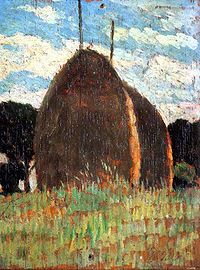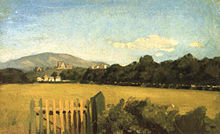Italian Neoclassical and 19th-century art
From the second half of the 18th century through the 19th century, Italy went through a great deal of socio-economic changes, several foreign invasions and the turbulent
The Italian Neoclassicism was the earliest manifestation of the general period known as
Classicist literature had a great impact on the
The art of Francesco Hayez and especially that of the Macchiaioli represented a break with the classical school, which came to an end as Italy unified (see Italian modern and contemporary art). Neoclassicism was the last Italian-born style, after the Renaissance and Baroque, to spread to all Western Art.
History and influences
Just like in other parts of Europe, Italian Neoclassical art was mainly based on the principles of

In the
Italy also developed several other artistic movements in the 19th century, like the
Prominent artistic movements
I Macchiaioli

The Macchiaioli were a group of Italian painters from Tuscany, active in the second half of the 19th century, who, breaking with the antiquated conventions taught by the Italian academies of art, painted outdoors in order to capture natural light, shade, and colour. The Macchiaioli were forerunners of the Impressionists who, beginning in the 1860s, would pursue similar aims in France. The most notable artists of this movement were Giovanni Fattori, Silvestro Lega and Telemaco Signorini.
The movement grew from a small group of artists, many of whom had been revolutionaries in the
They believed that areas of light and shadow, or "macchie" (literally patches or spots) were the chief components of a work of art. The word macchia was commonly used by Italian artists and critics in the 19th century to describe the sparkling quality of a drawing or painting, whether due to a sketchy and spontaneous execution or to the harmonious breadth of its overall effect.
A hostile review published on 3 November 1862 in the journal Gazzetta del Popolo marks the first appearance in print of the term Macchiaioli.[5] The term carried several connotations: it mockingly implied that the artists' finished works were no more than sketches, and recalled the phrase "darsi alla macchia", meaning, idiomatically, to hide in the bushes or scrubland. The artists did, in fact, paint much of their work in these wild areas. This sense of the name also identified the artists with outlaws, reflecting the traditionalists' view that new school of artists was working outside the rules of art, according to the strict laws defining artistic expression at the time.
In its early years the new movement was ridiculed. Many of its artists died in penury, only achieving fame towards the end of the 19th century. Today the work of the Macchiaioli is much better known in Italy than elsewhere; much of the work is held, outside the public record, in private collections there.

Purismo
Purismo was an Italian cultural movement which began in the 1820s. The group intended to restore and preserve language through the study of medieval authors, and such study extended to the visual arts.
Inspired by the
The group's ideals were iterated in their manifesto Del purismo nelle arti, in 1842–43 which was written by Antonio Bianchini and co-signed by Tommaso Minardi (1787–1871), the major proponent of Purismo, Nazarene co-founder Friedrich Overbeck and Pietro Tenerani.
References
- ^ "illa Almerico Capra detta "la Rotonda", Vicenza" (in Italian). Retrieved 30 December 2023.
- ^ a b "Italian Neoclassicism". Archived from the original on 6 June 2011. Retrieved 1 January 2010.
- ^ "Art and Culture of Milan: from the past to the contemporary". www.aboutmilan.com.
- ^ Broude, p. 3
- ^ Broude, p. 96

